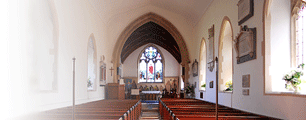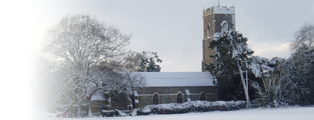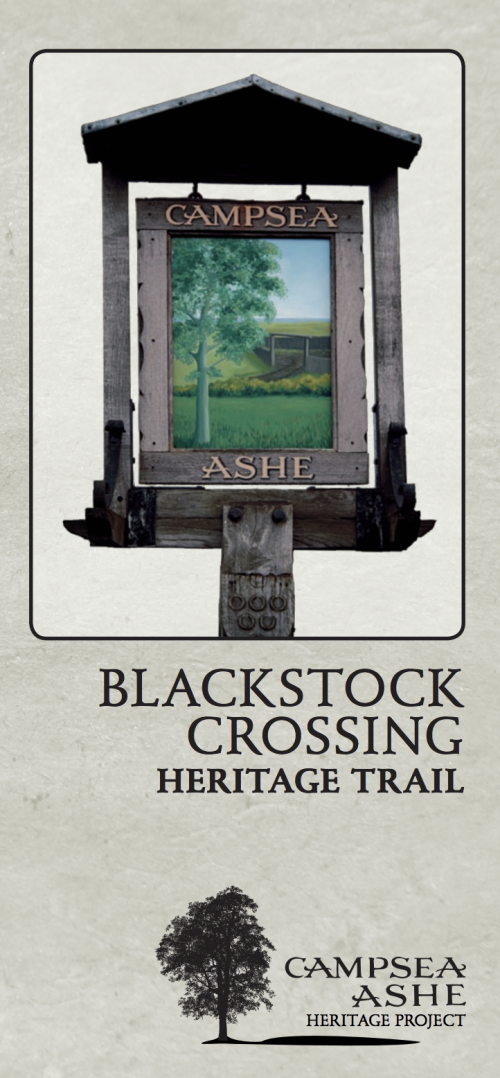Blackstock trail
Campsea Ashe is best explored using the specially commissioned and informative Heritage Trails.
Download the leaflet by clicking on the image to the left OR collect a free copy from the Church
The first of these is the Blackstock Crossing Trail which follows a roughly anti-clockwise route north-eastwards from the church and its associated buildings, skirts the western edge of the High House Estate, formerly the home of Viscount Ullswater and his family, and returns by doubling back across the railway – firstly at Blackstock Crossing and for the second time under the Marlesford Road bridge. The trail starts from the old village blacksmith’s cottage and the nearby ‘Triangle’ with the Village Sign, first erected in 1937 - along with the church Lych Gate - and restored in 1996. Close by, set in the hedgerow along the north side of the churchyard facing the road, is the War Memorial commemorating 17 fallen servicemen from the Great War.
Turning eastwards along the Tunstall Road, along the stretch between the Regency White House (1837) and the old Victorian School House, there is a glimpse down into The Pit, a sand quarry disused since the end of the18th Century. It now contains a small cluster of cottages, the oldest ones of flint and dating back to 1807. At the turn of the 19th-20th century several small business were thriving in and around The Pit, including a small village stores and a farrier / harness-maker. A little further along the Tunstall Road is The Hame, a distinctive country house and home of three maiden sisters, Julia, Violet and Evelyn Reade, who moved there in 1913 just after it had been built for them by the Lowther family, with whom they were friends.
Beyond The Hame the former High House Estate stretches away to the right hand side of the road. Much of it is now turned over to agricultural use, though there is enough remaining as park land to indicate its former status, in fact reckoned to be one of the oldest deer parks in Suffolk as it dates back to Tudor times or earlier. A pair of gates denoted ‘Ashe House’ mounted on white brick pillars mark the start of a majestic avenue of lime trees which extends back some 500 yards to where the mansion once stood. William Lowther bought the High House and its estate in 1882, and in their heyday the gardens are believed to have been heavily influenced by the work of Gertrude Jekyll, having featured long ‘canals’, and an arboretum of elms, horse chestnuts and cedars, many of which are still in place. These are not visible from the Blackstock Crossing Trail, but some evidence of the estate beyond the gates is traceable from the irregular depressions in the parkland, probable sites of former fishponds.
The original ‘High House’ was built in the 16th Century and was owned by the Glover family, aristocrats associated with Queen Elizabeth’s court. Tragedy was to strike the family in 1641 when one William Glover was murdered – ‘unhappily slain’ by two persons – at the White Hart Inn in Wickham Market. Ten years later the estate was sold to the Sheppard family of Mendlesham (15 miles to the north-west in Suffolk) whose descendants owned it through to the end of the 19th Century. The last member of the Sheppard family to have owned the High House was J G Sheppard who was foreman of the famous ‘Tichbourne trial’ of 1871 which ran from May until the end of August, dealing with a disputed inheritance. The mental and physical strain of the trail is said to have broken Sheppard, and its notoriety has resonances with the Jarndyce affairs in Charles Dicken’s Bleak House. The ‘High House’ itself - so named because the original building was four stories high – was demolished in 1953 after the rest of the estate was sold and the remaining coach house and stable buildings have now been converted into housing.
Along the road signposted to Blaxhall and Snape the countryside becomes essentially agricultural, with a gamekeeper’s spinney to the right before open fields. A little further up the road is another disused pit whose origins remain a mystery. Turning left at the Red House Farm junction, the Trail continues westerly towards Blackstock Crossing, and along this section it is possible to savour the ‘classic’ Suffolk countryside: gently undulating countryside with large open fields stretching across to a distant tree line, isolated brick cottages and the distant church tower – all under the huge Suffolk sky. The views are interrupted by the double line of high-voltage pylons which were erected in the 1960s, running at up to 400,000 volts to feed to feed power into the National Grid from the Sizewell nuclear power station near Leiston, over 10 miles away to the east. Beyond the pylons the lane descends to another wooded spinney, Blackstock Wood with its part-natural and part-managed drainage ponds and brooks that feed into the River Ore, taking run-off eventually to the River Alde and out to sea at Orford.
At Blackstock Crossing there is a tiny railwayman’s cottage. This is where the former Framlingham Branch Line turned northwest from a simple set of points - the so-called “Wickham Market Junction” – immediately beyond the crossing in the Saxmundham direction. The branch line was built in 1859 (along with the rest of the Ipswich to Halesworth rail link, completing the East Coast line from London Liverpool Street to Lowestoft), but closed to passengers in 1952 and for freight in 1965. Along the ancient Blackstock Lane there are views to the left, southwards across to Jolly’s Farm and the church, and you can hear the distant rush of traffic on the main A12 trunk road, a mile away to the north beyond the horizon.
Well House Cottages mark the site of one of the village pumps at the crossroads where Blackstock Lane intersects the Marlesford Road. The cottages are now a single dwelling but were formerly a pair dating back at least 200 years. Returning to the village under the power lines again, viewed to the left is a perfectly straight run of pylons as far as the eye can see, coming across the countryside from Sizewell. Crossing the railway again, approaching the dip under the Marlesford Road railway arch, the church tower with its small white-painted ‘spirelet’ comes into view. Beyond the arch is Bucks Head Cottage which was an Inn for at least 100 years – and reputedly frequented by smugglers - until the 1950s when it was converted to a private house. Immediately behind Bucks Head Cottage a steep track drops down into The Pit, but the road soon rejoins the B1078 Tunstall Road on its way back to the church.
Beyond the church to its right is The Old Rectory, an imposing 18th Century parsonage with a wide frontage. It was refurbished in 1826, and again from 1906 onwards, to become described by its then occupier as “a very charming and comfortable house, with a delightful garden and other amenities”. The Rectory was used as the headquarters and billets for the Women’s Land Army during the Second World War, but ceased to be the home of the incumbent rectors in 1951 when it was sold to become a private residence and small B&B hotel, which it remains. Next door to the Rectory is the so-called “Iron Room”, for a long time the Village Hall and community meeting place. Literally constructed from corrugated iron, this little building was used as a hospital during the Great War.



